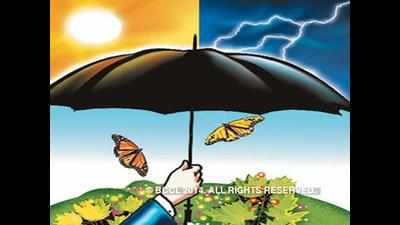- News
- City News
- dehradun News
- 2 weather stations soon to monitor climate change in Uttarakhand
Trending
This story is from November 26, 2017
2 weather stations soon to monitor climate change in Uttarakhand
The watershed management directorate of forest department which is implementing a Rs 1020 crore World Bank project to facilitate rejuvenation of water sources, watershed treatment and supporting local livelihood mainly agriculture in eight districts of the state is going to set up weather stations in Almora and Vikasnagar to update locals about fluctuations in climate change such as changing pattern of rainfall.

Dehradun: The watershed management directorate of forest department which is implementing a Rs 1020 crore World Bank project to facilitate rejuvenation of water sources, watershed treatment and supporting local livelihood mainly agriculture in eight districts of the state is going to set up weather stations in Almora and Vikasnagar to update locals about fluctuations in climate change such as changing pattern of rainfall.These districts which are Uttarkashi, Dehradun, Tehri, Pauri, Rudraprayag, Almost, Pithoragarh and Bageshwar under the project.
The main component of the project are social mobilization, watershed treatment and rainfed area development,, enhancing livelihood opportunities. The World Bank team which is coming to monitor the progress of the project in couple of days will visit different villages in Almora, Thatyur and Vikasnagar.
JC Pandey , environment specialist with the directorate said, “The weather stations will help in getting information about the pattern of rain and status of temperature and rain. Keeping the weather forecast in consideration , villagers are also being trained what to grow in the productive crops in the season which has heavy rainfall, medium or low. This way the villagers will be able to able to earn good income despite variation in weather.”
He said, specialized marketing teams too have been linked with these gram panchayat to facilitate marketing of their produce at profitable rates. He said, for the contingency planning under climate change, the villagers are trained to adapt themselves not only in various sectors such as agriculture, horticulture, animal husbandry.
She said, watersheds are being created in these gram panchayats adapting ridge to valley approach. “As the water runs off from top of the forest or hill to the village to so we have begun treatment from the top itself. In this task we have incorporated van panchayat also. The methods such as trenches, recharge pits, contour or vegetative bunds are being created to stop the running off rain water. This helps not only in recharging ground water but providing water to the villagers for their use.”
The main component of the project are social mobilization, watershed treatment and rainfed area development,, enhancing livelihood opportunities. The World Bank team which is coming to monitor the progress of the project in couple of days will visit different villages in Almora, Thatyur and Vikasnagar.
JC Pandey , environment specialist with the directorate said, “The weather stations will help in getting information about the pattern of rain and status of temperature and rain. Keeping the weather forecast in consideration , villagers are also being trained what to grow in the productive crops in the season which has heavy rainfall, medium or low. This way the villagers will be able to able to earn good income despite variation in weather.”
He said, specialized marketing teams too have been linked with these gram panchayat to facilitate marketing of their produce at profitable rates. He said, for the contingency planning under climate change, the villagers are trained to adapt themselves not only in various sectors such as agriculture, horticulture, animal husbandry.
Neena Grewal, additional director said , “The objective of the project known as GRAMYA is to increase the efficiency of nature resource use and productivity of rainfed agriculture by participating communities in selected micro-sheds across 468 gram panchayats of the state.
She said, watersheds are being created in these gram panchayats adapting ridge to valley approach. “As the water runs off from top of the forest or hill to the village to so we have begun treatment from the top itself. In this task we have incorporated van panchayat also. The methods such as trenches, recharge pits, contour or vegetative bunds are being created to stop the running off rain water. This helps not only in recharging ground water but providing water to the villagers for their use.”
End of Article
FOLLOW US ON SOCIAL MEDIA










